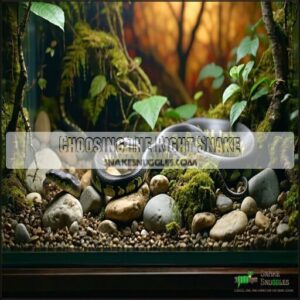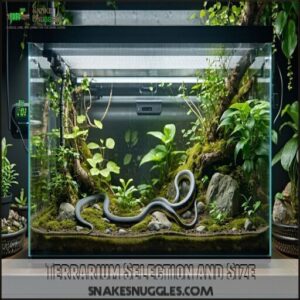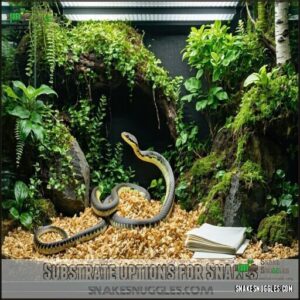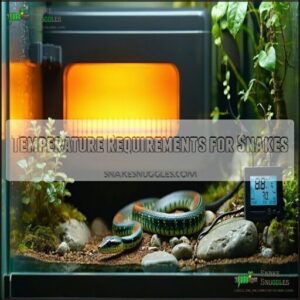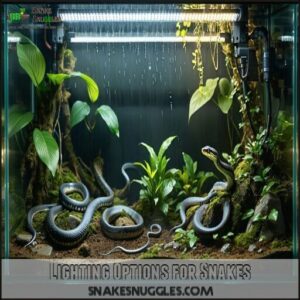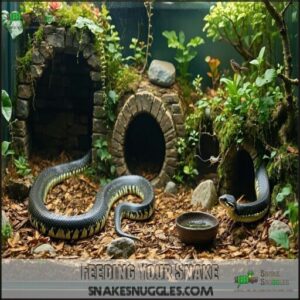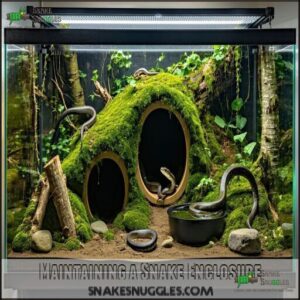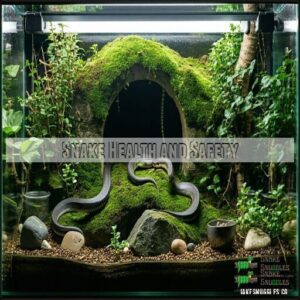This site is supported by our readers. We may earn a commission, at no cost to you, if you purchase through links.
 When setting up your snake enclosure, you’ll need to master a few key elements. Choose a terrarium at least twice your snake’s length with secure, well-ventilated locks.
When setting up your snake enclosure, you’ll need to master a few key elements. Choose a terrarium at least twice your snake’s length with secure, well-ventilated locks.
Create a precise temperature gradient—88-90°F on the warm side, low 70s on the cool side—using reliable heating equipment and digital thermometers. Select appropriate substrate like coconut husk for comfort and humidity control.
Include multiple hiding spots that mimic natural environments, giving your snake security and stress reduction. Monitor humidity levels carefully, aiming for species-specific ranges.
Regularly clean the habitat, replace water, and inspect for potential health issues. Your snake’s environment is its entire world, and maintaining a proper environment is crucial for its health and well-being. Ensure a stable environment to promote a long and healthy life.
Table Of Contents
- Key Takeaways
- Choosing The Right Snake
- Setting Up a Snake Enclosure
- Snake Habitat Essentials
- Feeding Your Snake
- Maintaining a Snake Enclosure
- Snake Health and Safety
- Creating a Snake-Friendly Environment
- Automation and Technology
- Troubleshooting Common Issues
- Ongoing Care and Maintenance
- Frequently Asked Questions (FAQs)
- How do you maintain a snake enclosure?
- How should a snake tank be set up?
- What should I put at the bottom of my snakes cage?
- What does a snake need in its cage?
- How often should I clean the snake enclosure?
- What substrate is best for snake enclosures?
- How do I maintain proper humidity levels?
- What signs indicate a snake is stressed?
- How can I safely introduce new decor?
- How do you handle aggressive snake behavior?
- Conclusion
Key Takeaways
- You’ll need to create a precise temperature gradient (88-90°F on warm side, low 70s on cool side) that allows your snake to naturally thermoregulate and maintain optimal health.
- Your snake’s habitat must include multiple hiding spots, strategic enrichment structures, and secure enclosure design to reduce stress and mimic their natural environment.
- You’ll have to monitor humidity levels carefully, using a hygrometer and selecting appropriate substrate like coconut husk to maintain species-specific moisture requirements.
- Regular maintenance is crucial – you’ll want to spot-clean daily, perform deep cleaning monthly, track feeding/shedding cycles, and schedule annual veterinary check-ups to ensure your snake’s long-term well-being.
Choosing The Right Snake
When choosing your first snake, you’ll want to select a species that matches your experience level and care capabilities.
Beginner-friendly pythons like Spotted, Children’s, and Stimson’s pythons offer gentle temperaments, compact sizes, and straightforward maintenance requirements that’ll help you build confidence as a new reptile keeper.
Popular Snakes for Beginners
Embarking on a snake care journey? Let’s explore beginner-friendly python species that’ll make your reptile adventure smooth and exciting.
These gentle serpents are perfect for first-time snake owners looking to venture into the realm of reptile handling.
- Spotted Pythons: Compact and calm
- Children’s Pythons: Docile and shimmery
- Stimson’s Pythons: Easy to manage
- Minimal care requirements
Choose wisely, and you’ll have a low-maintenance pet that transforms your snake habitat from intimidating to delightful, making for a great reptile adventure.
Spotted Pythons Characteristics
In the realm of pythons, Spotted Pythons from North Queensland are the cool, calm, and collected companions you’ll love.
These compact serpents max out at 100cm, offering a manageable snake experience for enthusiasts.
Here’s why they’re a standout choice:
- Gentle demeanor makes handling a breeze
- Compact size simplifies snake habitat design
- Stunning patterns add visual intrigue
- Minimal care requirements perfect for new python owners
Their easygoing nature and distinctive appearance make Spotted Pythons an ideal entry into the fascinating realm of python keeping.
Childrens Pythons Characteristics
Discover the Children’s Python, a compact snake species that shines with rainbow-like scales and an easygoing temperament.
These gentle reptiles are perfect for novice snake enthusiasts seeking a low-maintenance companion.
| Feature | Detail | Benefit |
|---|---|---|
| Size | 60-100cm | Manageable |
| Color | Shimmering | Attractive |
| Temperament | Calm | Beginner-friendly |
| Care Level | Low | Easy maintenance |
The details provided in the table highlight the key characteristics of the Children’s Python, making it an ideal choice for those new to snake care.
Stimsons Pythons Characteristics
After Children’s Pythons, meet the Stimson’s Python: a compact powerhouse of snake charm.
These red-blotched beauties max out around 102cm, perfect for beginners seeking a low-maintenance companion.
- Minimal Effort: Straightforward care requirements
- Calm Temperament: Gentle handling potential
- Stunning Patterns: Unique color morphs
- Space-Efficient: Compact snake enclosure needs
Their mellow nature and striking look make them a top pick for reptile enthusiasts ready to slither into snake ownership.
Setting Up a Snake Enclosure
You’ll need a carefully selected enclosure that meets your snake’s specific environmental requirements and guarantees its comfort and safety.
By understanding key factors like terrarium size, substrate selection, temperature gradients, and enrichment options, you’ll create a habitat that supports your serpent’s health and well-being.
Terrarium Selection and Size
After finding your perfect snake companion, it’s time to create its dream home. Your terrarium isn’t just a box—it’s a life support system.
Choose an enclosure at least twice your snake’s length, prioritizing spaciousness and security. Consider these key factors:
- Measure twice, buy once
- Lock down escape routes
- Breathe easy with proper ventilation
- Match size to snake species
- Future-proof your habitat design
Glass tanks with screened tops offer visibility and airflow. Remember: a well-designed terrarium keeps your slithery friend safe, comfortable, and thriving. When setting up a snake enclosure, understanding snake terrariums is essential for creating an ideal environment.
Substrate Options for Snakes
Once you’ve selected the perfect snake terrarium, choosing the right substrate becomes your next mission.
Substrate options range from tried-and-true aspen shavings to moisture-loving coconut fiber. Watch out for sand—it’s a risky choice that can lead to dangerous impaction.
Experiment with cypress mulch for humidity lovers, but keep an eye on potential mold growth. Paper towels offer easy cleanup, while aspen provides burrowing bliss.
Your snake’s comfort and safety depend on smart substrate selection. Researchers study snake substrate options to determine the best materials for snake enclosures.
Providing Enrichment for Snakes
After lining your snake’s habitat with safe substrate, it’s time to spark their curiosity.
Enrichment transforms a static enclosure into a dynamic playground.
Snakes thrive on mental stimulation that mimics their natural environment.
- Create climbing structures that challenge their agility
- Design hide boxes with varying textures and complexity
- Introduce snake toys that trigger natural hunting behaviors
To maintain a healthy environment, maintaining proper ventilation systems is vital for the well-being of your serpent.
Engage your serpent’s senses and watch them explore with renewed enthusiasm.
This setup will help create a stimulating environment that is essential for your snake’s overall health and happiness, providing them with a healthy environment and a chance to exhibit curiosity.
Temperature Requirements for Snakes
Want a happy, healthy snake? Master the art of temperature gradients! Your scaly friend needs a thermal paradise that mimics their natural habitat.
Set up a heat mat or ceramic heater to create warm and cool zones, with temperatures ranging from 88-90°F on the hot side to low 70s on the cooler end.
Use a reliable digital thermometer to track heat sources and guarantee precise temperature regulation.
Proper thermoregulation isn’t just comfort—it’s vital for your snake’s metabolism and overall well-being.
Lighting Options for Snakes
After establishing the perfect temperature gradient, your snake’s lighting setup becomes the next critical piece of the puzzle.
UVB lighting helps metabolize calcium, while LED fixtures and heat lamps provide warmth and visibility.
Mimic natural day-night cycles with a balanced photoperiod control system, using infrared heating for a gentle nocturnal glow that won’t disturb your slithery friend, providing a comfortable environment with infrared heating.
Snake Habitat Essentials
Creating the perfect snake habitat isn’t just about filling a tank—it’s about mimicking your serpent’s natural environment with precision and care.
Your snake’s health depends on mastering key habitat elements like temperature gradients, strategic hiding spots, and appropriate humidity levels that will transform a simple enclosure into a thriving reptilian sanctuary.
Importance of Humidity Control
Your snake’s comfort hinges on humidity levels that feel just right. Think of it like Goldilocks—not too wet, not too dry.
A reliable hygrometer becomes your moisture management sidekick, tracking humidity with scientific precision. Maintaining ideal humidity is vital for snake health, and understanding humidity control methods is key.
- Track humidity like a pro
- Mist strategically
- Create humid microclimates
- Choose smart substrates
- Monitor water bowl placement
Nail these tricks, and you’ll master humidity control for a happy, healthy serpent, achieving the perfect balance of humidity levels for your pet.
Creating a Temperature Gradient
One key to snake comfort is mastering temperature control through a precise thermal gradient.
Install a heat mat on one enclosure side, creating a warmth distribution zone ranging from 88-90°F.
Use a reliable thermostat to manage heat sources and guarantee your serpent can naturally thermoregulate, mimicking its wild habitat’s temperature cycling for peak health and well-being.
Providing Hiding Places for Snakes
After creating the perfect temperature gradient, your snake craves secret spots to feel secure.
Craft a sanctuary with strategic hiding places that mimic natural habitats:
- Place den boxes on warm and cool enclosure zones
- Use cork bark and rock caves for visual barriers
- Make certain hiding spots fit snugly, allowing full-body concealment
Your slithery friend will thank you with calm, confident behavior.
Incorporating Climbing Structures
After creating cozy hiding spots, it’s time to turn your snake’s home into a vertical playground.
Smart branch placement transforms an ordinary enclosure into an arboreal adventure.
Check out these climbing structure tips:
| Structure Type | Benefits | Installation | Safety Rating |
|---|---|---|---|
| Natural Branches | Mimics habitat | Secure firmly | High |
| Reptile Ramps | Easy navigation | Angled gently | Medium |
| Rock Ledges | Basking spots | Stable base | High |
| Vine Structures | Enrichment | Lightweight | Medium |
Feeding Your Snake
When feeding your snake, you’ll want to understand its unique dietary needs and select prey that matches its species, size, and age.
Frozen-thawed mice or rats, properly stored and handled, provide a safe and nutritious meal that guarantees your serpent’s health and prevents potential feeding complications.
Choosing The Right Food for Your Snake
Your serpent’s diet demands precision—choose prey that perfectly matches your snake’s body width.
Frozen-thawed options reign supreme in the reptile world for safety and nutrition.
Consider these key guidelines for ideal snake feeding:
- Match prey size to snake’s widest body part
- Prioritize frozen over live prey
- Thaw food completely before serving
- Store prey in labeled, airtight containers
- Monitor snake’s body condition regularly
Feeding Schedule for Snakes
Mastering your snake’s feeding rhythm is like conducting a precise dietary orchestra.
Not all snakes eat to the same beat—younger serpents typically need meals every 5-7 days, while adults can stretch between 10-14 days.
| Age Group | Feeding Frequency | Prey Size | Nutrition Notes |
|---|---|---|---|
| Juvenile | 5-7 days | Smallest | High energy needs |
| Young Adult | 7-10 days | Medium | Balanced growth |
| Mature Adult | 10-14 days | Largest | Maintenance mode |
| Breeding | Varies | Adjusted | Extra nutrition |
| Senior | 14-21 days | Smaller | Metabolism slows |
Size matters—prey should match your snake’s widest body point for safe, healthy meals.
Prey Item Options for Snakes
When feeding your snake, think variety but play it safe.
Frozen mice and rat pups make top-tier prey items for most species. Mix in quail chicks or feeder fish to keep mealtime interesting.
Always choose prey smaller than your snake’s width to prevent choking. Skip live feeding—it’s a risky game that can harm your scaly friend.
Understanding the benefits of live prey feeding is essential for snake owners. Stay smart, stay safe with your snake nutrition plan.
Managing Food Storage and Handling
Safeguard your snake’s meals by storing prey in airtight, labeled containers with purchase dates.
Thaw frozen prey slowly in the refrigerator—never at room temperature—to prevent bacterial growth.
Clean feeding tools thoroughly after each use.
Smart food safety isn’t just a recommendation; it’s your snake’s lifeline to a healthy, stress-free feeding routine.
Maintaining a Snake Enclosure
Maintaining your snake’s enclosure is essential for its health and happiness, requiring consistent attention to cleaning, temperature, and environmental conditions.
By implementing a regular maintenance routine that includes spot cleaning, humidity monitoring, and enrichment rotation, you’ll create a safe and comfortable habitat that supports your snake’s well-being.
Cleaning The Enclosure
Keep your snake’s pad sparkling clean with a rock-solid enclosure cleaning routine.
Daily spot-cleaning prevents nasty buildup, while weekly disinfection keeps bacteria at bay.
Grab reptile-safe disinfectants, wear gloves, and remove waste promptly. Thorough rinsing is non-negotiable.
A pristine habitat means a healthier, happier snake—and fewer vet bills. Think of cleaning as your snake’s spa day: quick, efficient, and totally transformative.
Monitoring Temperature and Humidity
Maintaining precise temperature control and humidity levels is your snake’s lifeline.
- Precision is the heartbeat of snake care—every degree and droplet matters in your serpent’s sanctuary.
Invest in a reliable digital thermometer and hygrometer to track thermal gradients.
Aim for 88-90°F on the warm side and low 70s on the cool side.
Consistent humidity monitoring prevents shedding issues and keeps your serpent comfortable.
Think of it as creating a microclimate that mimics their natural habitat.
Providing Fresh Water
After carefully monitoring temperature and humidity, your snake’s water needs become the next priority. Your reptilian friend relies on you for hydration.
Choose a heavyweight ceramic or stainless steel water bowl that won’t tip easily during curious explorations.
- Select a spill-proof water dish
- Refresh water daily
- Use filtered room-temperature water
- Position bowl in the cooler enclosure zone
Keep water clean, accessible, and ready for your scaly companion’s wellness. Proper water bowl maintenance is essential for preventing bacterial growth and ensuring your snake’s overall health.
Rotating Decorations and Enrichment
After ensuring your snake’s hydration, it’s time to keep their habitat fresh and exciting.
Rotate decorations like branches, textured logs, and hide boxes to spark curiosity. Use enrichment toys that challenge their problem-solving skills.
These sensory stimulation techniques prevent boredom and encourage natural behaviors.
Snake-safe decoration introduction maintains a dynamic, engaging environment that mimics their wild instincts.
Snake Health and Safety
Your snake’s well-being depends on understanding its health signals and creating a safe environment that minimizes stress.
By recognizing potential illness symptoms, implementing proper handling techniques, and preventing escape risks, you’ll guarantee your scaly companion stays healthy and secure in its carefully designed habitat.
You’ll be ensuring your snake’s overall health by following these guidelines, which emphasize the importance of a safe environment and proper handling.
Recognizing Signs of Illness in Snakes
Snakes silently signal health troubles—catching illness early prevents bigger problems.
Watch for these red flags in your serpent’s world:
- Dull scales that resist smooth shedding
- Labored breathing or unusual mouth gaping
- Crusty or swollen eye membranes
- Uncharacteristic hiding or lethargy
- Tiny parasitic hitchhikers crawling beneath scales
When something seems off, trust your instincts. A quick veterinary check can save your slithery friend from serious complications.
Your keen observation is their best defense. Regular monitoring of snake health issues, including common snake problems, is essential for early detection and treatment.
Managing Stress in Snakes
When your serpent companion starts acting strange, it’s time to tune into their stress signals.
Odd behaviors like skipping meals or excessive hiding can indicate your snake is feeling overwhelmed.
Create a calm environment with plenty of hiding spots and minimal disruptions.
Reduce handling during sensitive periods like shedding or post-feeding.
Use gentle, predictable interactions to build trust.
By understanding snake behavior and implementing smart stress management techniques, you’ll help your scaly friend feel secure and relaxed in their carefully designed habitat.
Handling Snakes Safely
Mastering snake handling is an art of respect and technique. Your approach determines the success of human-snake interactions.
Follow these critical snake handling tips:
- Support the snake’s body weight fully
- Move slowly and predictably
- Use a gentle, confident touch
- Remain calm and avoid sudden movements
A snake hook can help guide larger specimens without direct contact. Watch for stress signals like tail flicks or defensive postures. Remember, each snake has a unique temperament. By understanding their body language and maintaining a patient demeanor, you’ll build trust and guarantee safe, comfortable handling for both you and your reptilian companion.
Preventing Escape and Injury
After learning how to handle snakes safely, it’s time to outsmart their Houdini tendencies.
Your snake’s enclosure needs Fort Knox-level security to prevent great escapes.
Here’s your game plan:
- Install locking lids with zero wiggle room
- Seal potential exit routes with escape-proof mesh
- Design double-door systems for extra protection
- Choose smooth materials to prevent injury
Secure entry points mean happy, healthy serpents!
Creating a Snake-Friendly Environment
You’ll create a snake paradise by carefully selecting the right substrate, decorations, and hiding spots that mimic your serpent’s natural habitat.
Your goal is to design an enclosure that provides comfort, security, and enrichment, transforming a simple terrarium into a thriving ecosystem that supports your snake’s physical and psychological well-being.
Choosing The Right Substrate
At the heart of your snake’s comfort zone lies the substrate—a critical choice that impacts enclosure hygiene and your serpent’s well-being.
Your substrate options range from moisture-absorbing coconut husk to easily cleaned reptile carpet, each with unique advantages.
Substrate Type Best for Pros Cons Price
Pick wisely—your snake’s health depends on it.
Adding Decorations and Enrichment
After carefully selecting your substrate, it’s time to transform your snake’s habitat into a dynamic playground.
Add sturdy climbing structures, hide boxes, and safe decorative rocks to provide sensory stimulation.
Mix live or artificial plants for a naturalistic touch. Secure each enrichment item painstakingly—your slithery friend needs a stable, engaging environment that mimics their wild home.
Providing Hiding Places and Visual Barriers
Creating sanctuary spaces transforms your snake’s enclosure from a simple container to a thriving habitat.
Strategic hiding places reduce stress and mimic natural environments.
Consider these essential decor options:
- Dual-Side Hides: Place ceramic or cork bark shelters on warm and cool enclosure zones
- Design Variety: Mix smooth rocks, wooden branches, and textured hide boxes
- Material Selection: Choose non-porous, easy-to-clean surfaces like ceramic and smooth wood
- Coverage Strategy: Confirm visual barriers that block direct lines of sight
Snake paradise awaits!
Managing Noise and Vibrations
After arranging your snake’s perfect sanctuary of hiding spots, shield them from sensory overload with strategic noise management.
Your slithery friend thrives in tranquility, so minimize environmental disruptions:
- Relocate the enclosure away from loud household zones
- Install soundproofing foam or rubber padding underneath
- Choose silent pumps and earthquake-resistant equipment
Vibration reduction keeps your serpent stress-free and comfortable.
Automation and Technology
Modern technology can revolutionize your snake care routine, offering precise control over environmental conditions through smart devices and automated systems.
You’ll find timers, digital thermostats, and integrated monitoring tools can transform how you maintain your snake’s habitat, ensuring consistent and ideal living conditions, with smart devices.
Using Timers for Lighting and Heating
Tired of playing temperature tag with your snake’s habitat? Digital timers are your new best friend for stress-free snake care.
They’ll handle lighting schedules and heat cycles like a pro, letting you kick back while technology does the heavy lifting. Using digital timer products can greatly simplify the automation process.
| Timer Type | Accuracy | Cost |
|---|---|---|
| Analog | Low | $ |
| Digital Basic | Medium | $$ |
| Smart Digital | High | $$$ |
Automate your snake’s environment and reclaim your free time—precision meets convenience in one smart solution.
Automating Temperature and Humidity Control
Mastering temperature and humidity control transforms your snake’s habitat from basic to brilliant.
Smart automation systems like digital thermostats and humidity controllers let you dial in precise climate settings effortlessly.
With temperature sensors strategically placed, you’ll create perfect thermoregulation—keeping your serpent comfortable without constant manual adjustments.
Monitoring Snake Activity and Health
Behind every healthy snake lies a story told through consistent behavior and telltale signs.
By tracking appetite, defecation, shedding patterns, and weight changes, you’ll become an expert in snake health monitoring.
Quick observations can prevent potential problems, turning you into a proactive reptile guardian who catches issues before they escalate.
Smart Home Integration for Snake Enclosures
Your snake’s habitat can evolve with cutting-edge smart home technology.
Revolutionize your reptile’s environment through strategic tech upgrades:
- Deploy smart thermostats for precision temperature management
- Install humidity sensors to optimize shedding conditions
- Use automated feeders for consistent nutrition scheduling
- Implement remote monitoring systems for real-time tracking
- Integrate voice-controlled environmental controls for seamless adjustments
Sensor technology transforms snake care from guesswork to guaranteed comfort.
This approach ensures your snake receives the best possible care, leveraging smart home technology and strategic tech upgrades to create an optimal environment.
Troubleshooting Common Issues
You’ll inevitably encounter challenges when maintaining a snake enclosure, from escape attempts to unexpected health issues.
By understanding common problems and implementing proactive strategies, you can quickly resolve most snake habitat complications and guarantee your serpent’s ongoing well-being.
Managing Escape Attempts
From smart home tech to serpent security, your snake’s escape artistry demands vigilance.
Double-check those enclosure vulnerabilities with pro-level snake proofing techniques.
Secure locking mechanisms on lids prevent Houdini-like breakouts.
Fine-mesh ventilation screens block tiny escape routes.
Implement double-door entry systems as your ultimate defense strategy.
Weekly inspections catch wear and potential weak points before your slithery friend turns into a surprise wanderer.
Stay one step ahead in the escape prevention game with pro-level snake proofing techniques.
Dealing With Pests and Parasites
When pesky mites invade your snake’s sanctuary, swift action is key.
Scrub enclosures with reptile-safe cleaners, swap bedding frequently, and monitor humidity.
Use targeted mite control sprays and conduct regular parasite testing.
Maintaining impeccable snake hygiene prevents disease spread and keeps your slithery friend comfortable.
Remember: a clean habitat means a healthy, happy serpent!
Resolving Feeding Issues
Feeding problems got you stumped? Your snake’s mealtime mysteries can unravel with smart observation.
Check prey size—it should match your snake’s midsection width. Track feeding records to spot patterns and identify potential stressors.
Temperature, routine disruptions, or handling can trigger food refusal. When in doubt, stay calm and patient.
Adjust your approach, and watch your serpent’s appetite return.
Addressing Health Concerns
Detecting early warning signs of snake health issues can be a game-changer for reptile owners.
Watch for unusual swelling, changes in skin color, or behavioral shifts that might signal underlying respiratory problems or snake parasites.
Gentle handling and stress reduction are essential during health assessments.
When in doubt, consult a veterinarian specializing in reptile health for prompt disease diagnosis.
Regular health monitoring helps prevent serious complications and keeps your scaly companion thriving.
Ongoing Care and Maintenance
You’ll need a proactive approach to keep your snake healthy through consistent monitoring and maintenance of its habitat.
Regularly updating your enclosure log, scheduling veterinary check-ups, and staying informed about snake care will help you provide the best possible environment for your serpent companion, which requires a proactive approach.
Scheduling Veterinary Check-Ups
When your slithery companion shows quirks or changes, it’s time to ring up a reptile vet. Annual check-ups are your snake’s health insurance policy.
But here’s the scoop:
- Young snakes might need twice-yearly visits
- Blood tests catch hidden health hiccups
- Experienced vets can spot subtle symptoms
- Preventive care saves money long-term
- Each visit builds your snake’s medical history
Regular veterinary care keeps your serpent friend in top shape, and annual check-ups are essential for maintaining their health, which is why preventive care is crucial.
Keeping a Snake Enclosure Log
Your snake’s diary isn’t just a notebook—it’s your mission control. Track feeding times, shedding cycles, and behavioral quirks with precision.
Detailed snake enclosure logs transform random observations into powerful health monitoring tools. Capture every detail: prey size, feeding date, weight changes, and habitat conditions.
This systematic record-keeping becomes your secret weapon in proactive snake care. Effective snake care techniques are essential for maintaining a healthy and thriving serpent.
Updating and Upgrading The Enclosure
Tracking your snake’s habitat journal reveals when an upgrade becomes necessary.
Your serpent’s home should evolve with its growth and changing needs.
Consider these key renovation points:
- Evaluate current enclosure size and material durability
- Check ventilation and heating system effectiveness
- Assess potential safety improvements for snake proofing
Enclosure customization isn’t just maintenance—it’s about creating a dynamic, responsive environment that supports your reptile’s health and comfort through strategic habitat expansion.
Continuing Education for Snake Owners
Your snake care journey is like an ongoing adventure—always learning, growing, and adapting.
Stay connected through vibrant reptile communities to sharpen your skills.
| Resource Type | Focus Area | Benefit |
|---|---|---|
| Online Forums | Species Care | Expert Insights |
| Local Clubs | Networking | Hands-on Learning |
| Workshops | Veterinary Care | Professional Guidance |
| Conferences | Habitat Design | Cutting-Edge Techniques |
| Webinars | Nutrition | Specialized Knowledge |
Master owner responsibilities and watch your scaly companion thrive, ensuring they receive the best possible care through expert insights and hands-on learning.
Frequently Asked Questions (FAQs)
How do you maintain a snake enclosure?
Hold onto your reptilian dreams!
You’ll conquer enclosure maintenance by spot-cleaning daily, monitoring humidity with a hygrometer, and checking temperature gradients.
Disinfecting weekly with reptile-safe cleaners is also crucial to keep your scaly friend thriving.
How should a snake tank be set up?
You’ll want a spacious, secure terrarium with a temperature gradient, proper substrate, and adequate ventilation.
Choose PVC or front-opening solid top cages, ensuring escape-proof design and comfort for your scaly companion.
What should I put at the bottom of my snakes cage?
You’ll want to choose a substrate that mimics your snake’s natural habitat.
Opt for aspen shavings, coconut husk, or cypress mulch—materials that maintain humidity, provide comfort, and let your slithery friend burrow safely, which is crucial for their well-being in a natural environment.
What does a snake need in its cage?
You’ll need a secure habitat with a temperature gradient, safe substrate like coconut fiber, a water dish, hiding spots, and proper heating.
Maintain humidity levels and create a comfortable environment that mimics your snake’s natural habitat, ensuring a suitable space for your pet with proper heating.
How often should I clean the snake enclosure?
Like a well-oiled machine, your snake’s home needs regular TLC.
Spot-clean daily by removing waste and uneaten food.
Perform a deep, thorough cleaning monthly using reptile-safe disinfectants to maintain a healthy environment.
What substrate is best for snake enclosures?
Aspen shavings, coconut husk, and cypress mulch make exceptional snake substrates.
You’ll want to avoid sand and fine particles that could cause impaction.
Choose moisture-absorbing materials that support your snake’s comfort and health.
How do I maintain proper humidity levels?
When Sarah’s ball python struggled to shed, she learned humidity’s vital role.
Use a hygrometer, mist substrates like coconut husk, and place a water bowl to maintain 50-70% humidity levels for healthy snake living.
What signs indicate a snake is stressed?
You’ll spot stress in your snake through changes: frequent hiding, refusing food, excessive defensive postures, rapid breathing, unusual skin color shifts, or persistent restlessness that deviates from normal behavior patterns.
How can I safely introduce new decor?
Gradually introduce new decor, cleaning and quarantining items first.
Place objects strategically, avoiding sudden placement.
Observe your snake’s reaction carefully, and make certain decor doesn’t disrupt temperature gradients or create hiding spots that might trigger stress responses.
How do you handle aggressive snake behavior?
Over 70% of snake aggression stems from stress.
Stay calm, move slowly, and respect your snake’s space.
Use protective gear, avoid sudden movements, and seek professional advice if persistent aggressive behavior occurs.
Conclusion
Ultimately, creating a perfect snake enclosure setup is about understanding your serpent’s unique needs.
You’ll find success by carefully balancing temperature, humidity, and habitat complexity.
Remember, a well-designed snake enclosure isn’t just a home—it’s a thorough life support system.
By investing time in proper maintenance and attentive care, you’ll guarantee your snake thrives, transforming a simple terrarium into a healthy, enriching environment that supports your reptilian companion’s long-term well-being.
- https://en.wikipedia.org/wiki/Hygrometer
- https://talis-us.com/blogs/news/maintaining-optimal-humidity-for-corn-snakes?srsltid=AfmBOopvX0wzXzVpVq1_hRLIZ8kptU4hwTMlx2TcKnAD_AdbjdwYRJvo
- https://aminoapps.com/c/reptiles/page/item/maintaining-humidity-in-glass-tanks-ball-pythons/WJdV_d3rIVIRoaaY5kEgzqBJ7m1de8B1BJ4
- https://familysnake.com/guides/keeping-your-snake-happy-how-to-monitor-humidity-levels/
- https://www.reptilecentre.com/blogs/reptile-blog/5-ways-to-increase-humidity-for-reptiles

